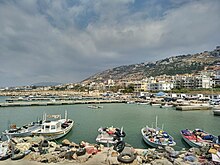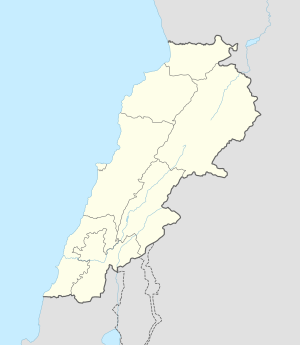
This is a demography of the population of Lebanon including population density, education level, health of the populace, economic status, religious affiliations and other aspects of the population.
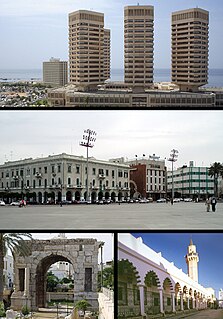
Tripoli is the capital and largest city of Libya, with a population of about 1.1 million people in 2019. It is located in the northwest of Libya on the edge of the desert, on a point of rocky land projecting into the Mediterranean Sea and forming a bay. It includes the port of Tripoli and the country's largest commercial and manufacturing center. It is also the site of the University of Tripoli. The vast Bab al-Azizia barracks, which includes the former family estate of Muammar Gaddafi, is also located in the city. Colonel Gaddafi largely ruled the country from his residence in this barracks.
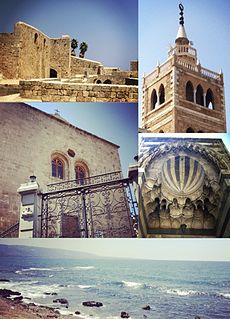
Tripoli is the largest city in northern Lebanon and the second-largest city in the country. Situated 81 km (50 mi) north of the capital Beirut, it is the capital of the North Governorate and the Tripoli District. Tripoli overlooks the eastern Mediterranean Sea, and it is the northernmost seaport in Lebanon. It holds a string of four small islands offshore. The Palm Islands were declared a protected area because of their status of haven for endangered loggerhead turtles, rare monk seals and migratory birds. Tripoli borders the city of El Mina, the port of the Tripoli District, which it is geographically conjoined with to form the greater Tripoli conurbation.

Mount Lebanon is a mountain range in Lebanon. It averages above 2,500 m (8,200 ft) in elevation, with its peak at 3,088 m (10,131 ft).

Tripoli is a city in the central part of the Peloponnese, in Greece. It is the capital of the Peloponnese region as well as of the regional unit of Arcadia. The homonym municipality has around 47,000 inhabitants.

Uganda is an overwhelmingly Christian majority country, with Islam being the second most widely professed faith. According to the 2013 National Census, Islam in Uganda was practised by 13.7 percent of the population. The Pew Research Center in 2014, however, estimated that 11.5 percent of Ugandans were Muslim, compared to 35.2 percent of Tanzanians, 9.7 percent of Kenyans, 6.2 percent of South Sudanese, 2.8 percent of Burundians, and 1.8 percent of Rwandans. The vast majority of Muslims in Uganda are Sunni. Small Shia and Ahmadi minorities are also present.

North Governorate is one of the governorates of Lebanon. Its capital is Tripoli. Ramzi Nohra has been its governor since May 2, 2014. The population of North Governorate is 731,251.

The official religion of Pakistan is Islam, as enshrined by Article 2 of the Constitution, and is practised by approximately 96.47% of the country's population. The remaining less than 4% practice Hinduism, Christianity, Ahmadiyya, Sikhism and other religions. A few aspects of Secularism have also been adopted by Pakistani constitution from British colonial concept. However, religious minorities in Pakistan often face significant discrimination, subject to issues such as violence and the blasphemy laws.

El-Mina or El Mina, is a coastal independent town in Tripoli, Northern Lebanon. El-Mina occupies the location of the old Phoenician city of Tripoli. It acts as the harbour city for modern neighbouring Tripoli, Lebanon's second-largest city, situated 5 km to the east.

Christianity is a minority religion in Libya. It has been present in Tripolitania and Cyrenaica since Roman times.

Lebanon is an eastern Mediterranean country that has the most religiously diverse society within the Middle East, comprising 18 recognized religious sects. The primary religions are Islam and Christianity. The Druze are about 5% of the citizens. Outside of Lebanon, Lebanese people are mostly Christians. It is also estimated that a large proportion of its population are refugees, which affects statistics. The refugees, mostly Syrian or Palestinian, are predominantly Sunni but also include Christians and Shia.

Islam is the dominant religion in Libya. Other than the vast majority of Sunni Muslims, there are also small Christian communities, composed exclusively of immigrants. Coptic Orthodox Christianity, which is the Christian Church of Egypt, is the largest and most historical Christian denomination in Libya. There are over 60,000 Egyptian Copts in Libya, as they comprise over 1% of the population alone. There are an estimated 40,000 Roman Catholics in Libya who are served by two Bishops, one in Tripoli and one in Benghazi. There is also a small Anglican community, made up mostly of African immigrant workers in Tripoli; it is part of the Anglican Diocese of Egypt.

Ottoman Syria refers to divisions of the Ottoman Empire within the region of Syria, usually defined as being east of the Mediterranean Sea, west of the Euphrates River, north of the Arabian Desert and south of the Taurus Mountains.
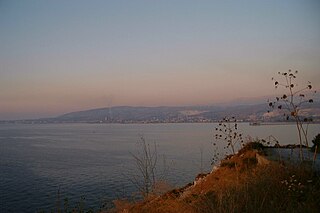
Akkar District is the only district in Akkar Governorate, Lebanon. It is coextensive with the governorate and covers an area of 788 km2 (304 sq mi). The UNHCR estimated the population of the district to be 389,899 in 2015, including 106,935 registered refugees of the Syrian Civil War and 19,404 Palestinian refugees. The capital is at Halba.

The Bab al-Tabbaneh–Jabal Mohsen conflict was a recurring conflict between the Sunni Muslim residents of the Bab-al-Tibbaneh and the Alawite residents of the Jabal Mohsen neighbourhoods of Tripoli, Lebanon. Residents of the two neighborhoods have been rivals since the Lebanese Civil War, and have frequently engaged in acts of violence. They are divided along sectarian lines, as well as by their opposition to or support of the Alawite-led Syrian government. Violence flared up during the Syrian Civil War spillover in Lebanon.
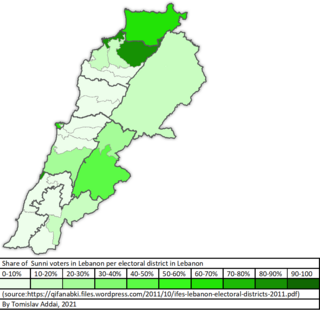
Lebanese Sunni Muslims refers to Lebanese people who are adherents of the Sunni branch of Islam in Lebanon, which is one of the largest denomination in Lebanon tied with Shias. Sunni Islam in Lebanon has a history of more than a millennium. According to a CIA 2018 study, Lebanese Sunni Muslims constitute an estimated 30.6% of Lebanon's population.

Sierra Leone is officially a secular state, although Islam and Christianity are the two main and dominant religions in the country. The constitution of Sierra Leone provides for freedom of religion and the Sierra Leone Government generally protects it. The Sierra Leone Government is constitutionally forbidden from establishing a state religion, though Muslim and Christian prayers are usually held in the country at the beginning of major political occasions, including presidential inauguration.

Islam in Lebanon has a long and continuous history. According to an estimate by the CIA, it is followed by 67.8% of the country's total population. Sunnis make up 31.9%, Shias make up 31.2%, with smaller percentages of Alawites and Ismailis. The Druze community is designated as one of the five Lebanese Muslim communities, even though most Druze do not identify as Muslims, and they do not accept the five pillars of Islam.

Laqlouq, also spelled Laklouk and also known as ′Arab Laqlouq is a small mountainous village in mountainous area in the Byblos District of Keserwan-Jbeil Governorate, Lebanon. It is located 69 kilometers northeast of Beirut. Laqlouq has an average elevation of 1,780 meters above sea level and a total land area of 210 hectares. Most of the inhabitants are Sunni Muslims, in contrast to the majority of Byblos District's population, which is largely Maronite Christian with a significant Shia Muslim minority.

